Using Recycled Water – What You Should Know
By Jim Farr
Water is precious and recycling can help preserve this resource
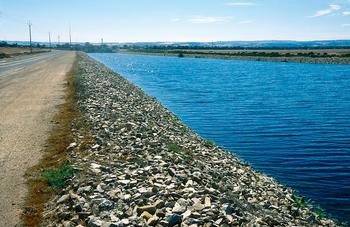
Currently, in California, about 10 % of wastewater in municipal and industrial usage is recycled and about 20% of that recycled water is used for landscape irrigation. Over time, this percentage is expected to greatly increase. The need for recycled water continues to grow and more Californians are using recycled water in their yards than ever before. The use of recycled water will help alleviate water shortfalls from the drought and can help consumers save on high water bills.
The use of recycled water extends across most of the counties in the Bay Area and includes Alameda County. Some consumers have noticed certain plants in their yard beginning to turn brown and die after using recycled water. This is an issue that consumers should be aware of and understanding what is happening will give consumers strategies to avoid this problem in the future.
Recycled, Reused, Reclaimed, Grey Water Defined
According to the California Department of Water Resources, recycled water is “highly treated wastewater from various sources such as domestic sewage, industrial wastewater and stormwater runoff.” This water has been through three levels of treatment including filtration and disinfection.
The terms “reused” and “recycled” are often used interchangeably depending on where you are geographically. Reclaimed water is not reused or recycled until it is put to some purpose.
Grey water is untreated, non-disinfected household wastewater that does not include toilet waste. It may be sourced from showers, baths, and washing machines.
Differences Between Recycled Water and Clean, Potable Water
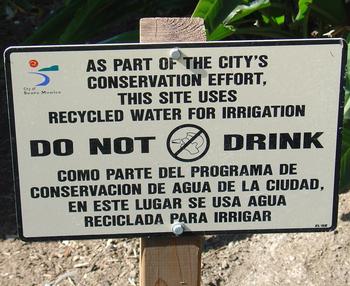
Recycled water has been highly treated and is good for irrigation but not drinking
While recycled water is very similar to clean potable water, there are some differences. One of these differences is that recycled water has a greater level of dissolved salts than potable drinking water. In public recycled water analysis available online, the salt concentration is expressed as higher numbers for total dissolved solids, conductivity, and salinity. While it is outside of the scope of this blog to discuss each of these in detail, higher numbers for these found in recycled water represent an overall higher concentration of salt in the water. These higher levels of salts can affect some plants.
Why is the Salt in Recycled Water a Problem for Plants?

As plants transpire (i.e. release moisture into the air through their leaves), roots pull water out of the soil, carrying some of the salts in the soil with it into the plant. If chloride, sodium and/or other ions reach damaging concentrations, leaf chlorosis and/or burn symptoms develop. Three major effects of high salinity on plants and soils are
- Prevents water moving from the soil up into the plant (sometimes referred to as increasing osmotic pressure);
- Salt ions, notably sodium, chloride, and boron, accumulate in plant cells to a harmful concentration;
- Slow water infiltration and soil permeability due to excess sodium breaking down soil aggregates leading to more compacted soil.
Plants Vary in Their Tolerance for Salt
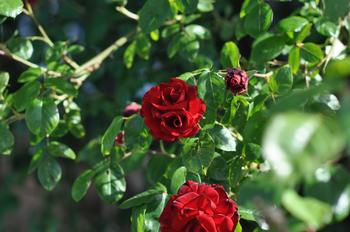
Plant species vary widely in their tolerance or sensitivity to salts and specific ions (see references at end of article). Plants with moderate to high salt tolerance, including many drought tolerant plants, are adapted to sites that contain elevated concentrations of salt that may be too high for salt-sensitive plants. Examples of these more extreme salty environments include arid areas where the salt concentration is high in the soil or along coastlines where there is exposure to salty air and ocean sprays.
However, some plants familiar with homeowners in their front and backyards are highly salt sensitive and the higher level of salt in recycled water can harm these plants. For example, some common plants with very low tolerances for salt are Camellias, Butterfly Bushes, and Roses. Trees that have a low tolerance to salt include Liquid Amber, Albizia, Red Maple, Ginko, Crepe Myrtles, and most types of Citrus.
Bay area water municipal districts have highlighted the issues associated with the higher salt concentration of recycled water on their websites, however, it is something not commonly known by consumers. For example, the Dublin San Ramon Service District includes this message at the bottom of the web page on recycled water quality:
“Most plants thrive with recycled water's higher nutrient content but some plants are sensitive to the higher salt content. The Tri-Valley Water-Wise website has a list of plants known to tolerate higher salt content, as does East Bay Municipal Utility District's award-winning book, Plants and Landscapes for Summer-Dry Climates of the San Francisco Bay Region.”
All classes of plants: trees, shrubs, vines, ornamental grasses, and groundcovers have examples of plants with a low tolerance for salts. A variety of tables are available to determine which plants and trees have low salt tolerance, these include Trees, Shrubs, Ground Covers and Vines, and Ornamental Grasses. Researchers at the University of California and at other research institutions continue to study this issue and continue to update lists of plants that have low, medium, and high salt tolerance.
What To Do If Recycled Water is Affecting Your Plants
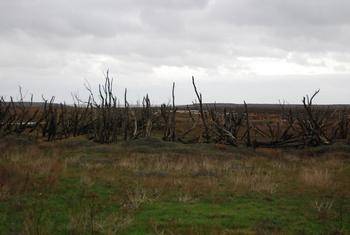 ©Nigel Chadwick licensed for reuse under the Creative Commons Attribution-ShareAlike 2.0 license
High salt in recycled water can kill salt-sensitive trees, shrubs, and plants
©Nigel Chadwick licensed for reuse under the Creative Commons Attribution-ShareAlike 2.0 license
High salt in recycled water can kill salt-sensitive trees, shrubs, and plants

If you are using recycled water and notice that some of your plants are showing signs of browning and don’t look healthy, check the tables above to see if these plants and trees are on the list of low salt tolerance. If you do choose to replace plants that have died from higher salt levels in the water, make sure to replace them with any of the many plants that have high salt tolerance.
Also, if you notice trees and shrubs in your local park beginning to turn brown, let your city parks and recreation department know. Many parks in the bay area now are irrigated with recycled water. Parks and Recreation Departments are sometimes not fully aware of the impact of recycled water on the plants in their parks. This can result in the early death of trees in parks, in particular, Maple Trees and some Evergreens have low salt tolerance.
Recycled Water Conserves Precious Water But Understand Its Effects on Plants
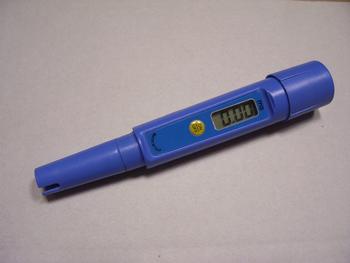
REFERENCES
- Tables of Salt Sensitive and Salt Tolerant Plants
- Tolerance of popular landscape species to salt spray and soil salinity are presented for trees (Table 2_02), shrubs (Table 3_02), groundcovers and vines (Table 4_02), and ornamental grasses (Table 5_02).
- Mulching
- University of California Urban Water Use Study
- Outstanding Plants for Alameda County
- EBMUD Water Smart Plants
- UC Davis Arboretum All-Stars
- Water Use Classification of Landscaping Species (WUCOLS) – Very comprehensive database with a great search tool
Water Wise Tips for Container Gardens:
Still Need Help?
Would you like more information or help with other gardening issues? Email us at acmg@ucanr.edu. Or contact us through our website http://acmg.ucanr.edu/Contact_Us/ .

